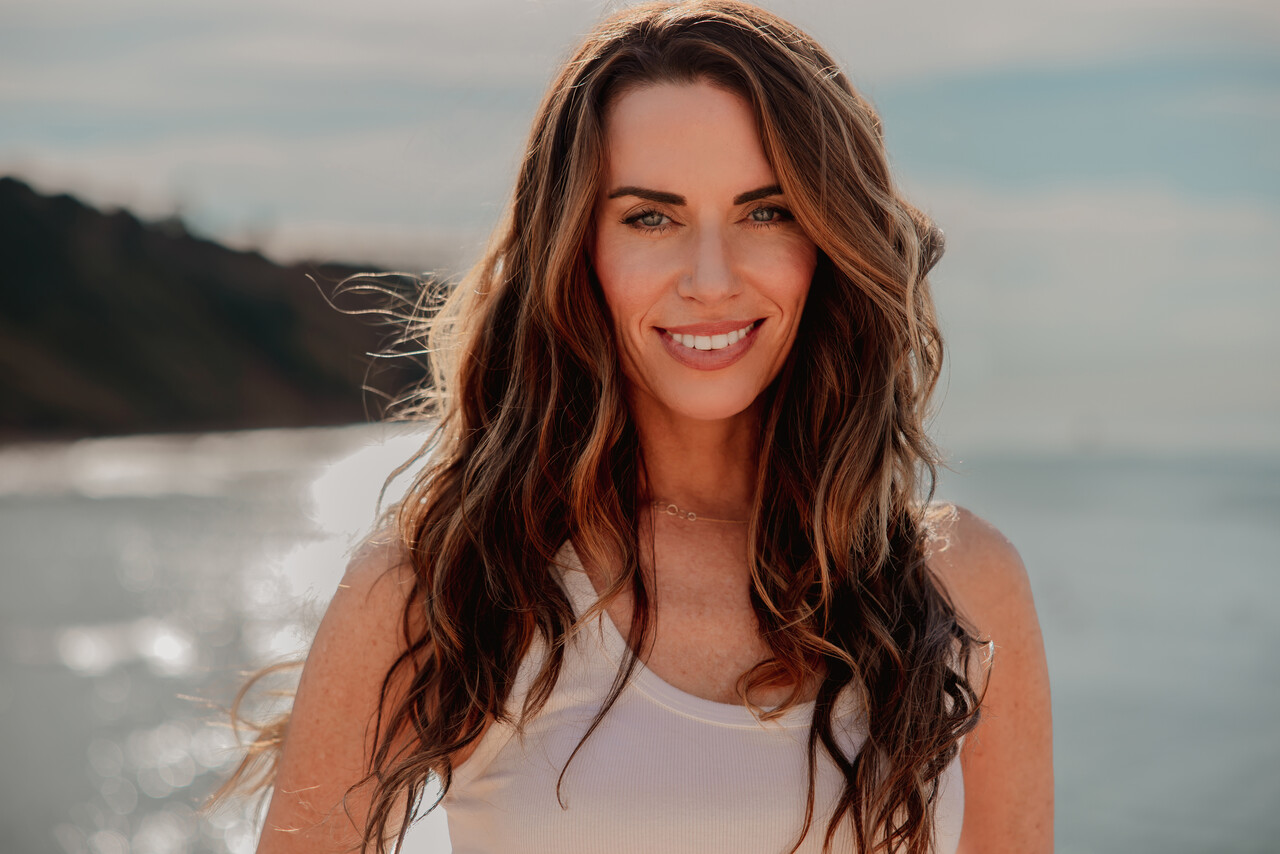Is there anything better than a bike ride along the coast?
The sea breeze with seagulls flying overhead. Ah… I LOVE my hometown!
Manhattan Beach was once a hidden gem surfer town. Today it’s a little less hidden and a bit more than a town, but it still has that locals-only feel, and the beach remains the place to be.
Even though I grew up there, the beauty and wonder of the beach never gets old. Each day the same view looks 100 different ways, the colors of the sky and sea changing with the sun, the weather, the tides, and the swells. When I have sand between my toes and the ocean spray in my hair– that’s my slice of heaven.
My moment of joy. As the waves crash before me, I can feel the joy flow through my body all the way down to my feet tucked into the warm white sand.
Emotions are shaped like waves. They slowly rise, peak, and eventually come back down, then another emotional wave comes and replaces it. When allowed to peak and to be expressed at their fullest, emotions actually only last about 90 seconds at most. You may have experiences that feel quite different from that, but emotions do come and go.
Here’s the catch – emotions can be sustained for much longer than 90 seconds when you feed them with your thoughts or your stories. We all get caught in emotional riptides from time to time.
That’s why getting to know the 5 core emotions is a powerful tool for your personal growth.
Yep, naming your emotions can be a good thing!
So often we’re taught you’re supposed to be objective and to not get emotional. I’ve got news for you, you are emotional. Welcome to planet earth, you’re a human being. Let’s learn how to work with it.
One of the reasons emotionality gets a bad rap is because a lot of perpetual emotion is fueled by Drama.
When you feed an emotion with your story about why you feel it, why it’s justified or why you shouldn’t feel it and it’s not allowed, you tend to reinforce the feeling and get stuck in what’s called a cognitive emotive loop. And the more you try to avoid actually feeling the feeling and blocking the energy from moving back through and out of you, the more you are going to extend the life of that emotion in your body.
Clamped-down emotion becomes stagnant and stuck within you. This can even manifest as physical sensations like pain and tension because the emotion isn’t moving through and out. And often we’ve got a story about why we won’t let it through and out. Maybe it’s too big, maybe it’s the wrong emotion. Maybe it doesn’t make sense and we’re busy trying to understand it. Maybe we just feel really, really right about the cause and we don’t want to let it go yet.
Luckily, if you want to get out of these cognitive emotive loops, there is a way to sift through the stories that keep you in drama and emotional loops and shift into healthy emotional patterns that move through you, not drain you.
Using the fact versus story framework, you can guide yourself out of Drama and into your authentic feelings.
Without the mudding effects of Drama, you are able to narrow your focus onto the few things you can control and stop putting extra emotion and energy into what ultimately leaves you drained.
How Fact vs. Story Influences Your Emotions
When you’re expressing something as complicated and personal as an emotion, it is important to practice intentional speaking by using words that are grounded in facts.
Intentional speaking can sound deceptively simple. But when you apply it, especially from a state of threat, drama, or being triggered, you may find that it’s actually really difficult to break out of story language. Our emotions are often so tied up in story thoughts that it can be difficult to focus on the simple question of what you feel right now at a basic level.
A powerful tool is to just begin to use the simple, basic emotion language that you learned when you were four sitting in your city library or listening to your parents talk or watching television- I’m sad, I’m happy, I’m joyful, I’m angry, I want something, or I’m scared. Each of these core emotions has a specific way it shows up in your body and a pearl of specific wisdom that wants to be listened to.
If you stay stuck in a story emotion, you don’t get that information. When you include story emotions in your description of how you’re feeling, you miss out on a lot of the intelligence that this current moment has to offer you. Focusing on facts helps you learn from your emotions as they move through you.
Here’s a fact vs. story refresher:
A fact is simply a report of the objective reality that you are observing. You can observe this through your body senses and also your mind. You have observations that are both in the outside world as well as in your internal world.
A story is simply an interpretation of observable facts and events that give them meaning. If it’s not objectively true, and not a fact, it’s a story. Most of what we tend to talk about in our daily lives are stories because storytelling is how humans connect to one another.
The reason it’s so critical for conscious leaders to strip out the story words in our language is that all story words come from drama. Shifting to a fact-oriented mindset helps keep you out of drama and helps you to stop spreading drama.
When you begin to experience your emotions with a fact-based lens rather than a story-based one, you give yourself the space to feel your basic, authentic feelings.
You have power and presence and a place to start from to begin to take creative action as the leader of your life when you’re grounded in the facts of the here and now moment. Viewing your emotions through a fact-oriented lens makes you productive, creative, and learning-oriented.
The simple act of naming your emotions can quickly and dramatically bring you out of a state of threat and drama and into a state of presence and trust. The thoughts and actions that come out of a state of presence are more productive, easeful, and creative.
As you live and lead from a state of presence, you work towards stabilizing your moods to heal and repair your nervous system and bring yourself back into a place of clarity. With clarity, you can be your most creative, your most calm and open, and do your best work.
The Wisdom of the 5 Core Emotions
There’s no right or wrong way to feel. And counter to popular belief, there’s no emotion that’s better or worse than any other emotion.
Every emotion is equally valuable because each of them brings with it a specific form of value or wisdom, a message of the emotion. Emotion arrives to wake you up to something and to guide you.
There are 5 core emotions: joy, sadness, fear, anger, and desire. Our ego wants to resist this and make emotions more complicated than they need to be, but there are 5 core emotions.
The wisdom of joy is that there is something to be appreciated and celebrated. The wisdom of fear is that there may be something new that’s going to happen. There is something you don’t know about yet, something for you to learn.
The wisdom of fear is the wisdom of being in the unknown.
The wisdom of anger is that there’s something that does not serve you or what you value. There’s something present that doesn’t serve you, your people, your commitments, the things to which you are most deeply committed.
The wisdom of sadness is that something has been lost. There’s something that has been lost that is being grieved.
The last of the five core emotions is desire. Desire includes creative and sexual feelings. The wisdom of desire is that there’s something here to be created, there’s something new that’s going to be born. And this is the one I find we most often clamp down on because we don’t trust that creative impulse. And we don’t trust that sexual impulse to go and make something new.
Now that you know what the five basic emotions are and you understand that there’s wisdom to each of them, my invitation for you is to live a life where you are committed to feeling your authentic feelings through to completion.
Why? Because it frees up your energy. Allowing your emotions removes the friction of trying to control, manage, explain away, avoid, or escape your feelings. After listening to the wisdom of your emotion as it’s passing through, you’ll be guided to making choices and taking action in your life in ways that are divinely intelligent and beneficial to you.
Challenge yourself to feel your feelings when they show up exactly as they show up and as big as they show up.
Allow Yourself to Feel Your Emotions
The key takeaways about emotions are: you have them, you’re going to keep having them, emotions are safe to feel, emotions will pass quickly, and we create our own emotions with our thoughts.
You are Allowed to be emotional. You are Allowed to learn. You are Allowed to feel. You are Allowed to grow.
Dare yourself to feel the emotions that are present. Ride the wave and experience the emotion fully in your body. Allow that emotion to do its thing inside of you without needing to analyze or understand it. The learning is in the feeling. Allow the emotion to move through you quickly so you don’t stay stuck with emotions and miss out on the opportunity to use them as creative fodder for your life leadership.
Feel your authentic feelings and listen in for their wisdom.

